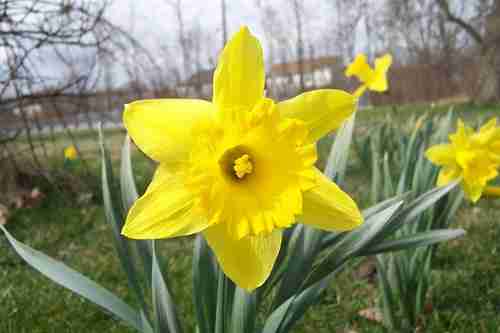Tim Schipper of Colorblends.com shares his choices for planting spring bulbs that deter munching mammals. This content is provided copyright-free for editorial use in whole or in part. I received no compensation from the author or distributor, Ferguson Caras LLC.
I have had great success with most of these bulbs. Daffodils, Snow Drops, Snowflakes and checkered Lily all worked to deter bulb munchers.
Here are more bulbs I know I want to try. Thanks Tim for the advice! Plant in fall and enjoy in spring! I see a field of flowers already!
“The solution to animal damage is to plant spring-bloomers that animals consider the last choice on the menu,” says Tim Schipper of Colorblends, a Connecticut-based flower bulb wholesaler that sells direct to land care professionals and home gardeners coast-to-coast.
Following are flower bulbs identified by Colorblends.com as the least likely to be eaten where munching mammals are an issue.
Deer- and Rodent-Proof Bulb Flowers:
The only truly deer- and rodent-proof bulbs are members of the Amaryllis family, which includes daffodils, snowflakes and snowdrops. They contain a toxic alkaloid called lycorine that mammals can detect and won’t eat.
- Daffodil. See Narcissus.
- Galanthus (snowdrop). Blooming in late winter and early spring, snowdrops are the earliest blooming spring bulbs. Their pendant white flowers signal that spring is on the way.
- Leucojum (snowflake). The pendant, white bell-shaped flowers of Leucojum look like tiny ballerina skirts draped daintily off 18-inch stems. They bloom in mid to late spring. A bulb flower that likes “wet feet,” it’s well suited to planting in soggier sites, even those areas where skunk cabbage thrive.
- Narcissus (daffodil). These spring favorites flower in early to late spring, depending upon the variety. All are prolific bloomers, with beautiful flowers of yellow or white with cups of yellow, white, orange, red-orange, apricot or bi-colors.
Deer and Rodent-Resistant Bulb Flowers:
The following bulb flowers are considered resistant to foraging rodents and/or deer, being unpleasant to smell or eat. Deer and rodents will generally avoid them but might take a bite if the plants or bulbs are directly in their path or if harsh seasonal conditions leave them with few other food options.
- Allium (flowering onion, ornamental onion). Alliums bloom in late spring and early summer, and thrive when planted in full sun. Best-known are the tall varieties topped by purple or white ball-shaped flowers. Others are lower growing with pink, yellow or white flowers. They may be vulnerable to bulb damage when vole populations are dense. Deer resistant.
- Camassia (quamash). Blooming in mid to late spring, camassia thrives in damp sunny locations. These native American beauties have starbursts of periwinkle blue flowers arranged loosely on three-foot spikes. Rodents may the eat bulbs. Deer resistant.
- Chionodoxa (glory-of-the-snow). Delicate-looking but tough, Chionodoxa blooms in early spring. It likes sun or light shade. Mass woodland or lawn plantings create a starry lavender-blue carpet in spring. Deer and rodent resistant.
- Daffodil, see Narcissus under deer- and rodent-proof bulbs.
- Eranthis (winter wolf’s bane, winter aconite). Eranthis blooms in very early spring, bringing bright color to woodland settings and sunny areas too. The plant is low growing. A hulu skirt of reflexed leaves encircles its yellow buttercup-flowers. Deer and rodent resistant.
- Fritillaria imperialis (crown imperial). A tuft of leaves that recalls a punk haircut tops this statuesque mid-spring bloomer. Its large, pendulous orange-red or yellow flowers ride atop a sturdy three-foot stem. It is not recommended for planting in the South. The big bulbs and towering plants smell rather skunky, turning most animals away. Deer and rodent resistant.
- Fritillaria meleagris (snake’s head, checkered lily). These mid-spring bloomers present an appealing wildflower look. Unlike most bulbs, which like “dry feet” and lots of sun, Fritillaria meleagris will thrive in damp areas and in partial shade. They are a great choice for planting in meadows, around shrubs, in woodland areas or in damp places near brooks and ponds. Their checkered, maroon bell-shaped blooms are pendant and nod daintily on a spring breeze. The occasional white bloom sets off its darker companions. Burrowing rodents may eat the bulbs. Deer resistant.
- Galanthus (snowdrop). See deer- and rodent-proof bulbs.
- Ipheion (starflower). Ipheion blooms in mid-spring. It is a low-growing bulb flower with slender grassy leaves and long-lasting, star-shaped white or blue flowers. It performs best when planted where summers are hot and winters are not too cold. Burrowing rodents may eat the bulbs. Deer resistant.
- Leucojum (snowflake). See deer- and rodent-proof bulbs.
- Narcissus (daffodil). See deer- and rodent-proof bulbs.
- Scilla (blue squill). Blue squill blooms in early spring. Once established, it creates a carpet of electric-blue flowers, a perfect companion to early miniature daffodils. Deer and rodent resistant.





